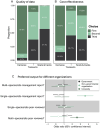Large-scale and long-term wildlife research and monitoring using camera traps: a continental synthesis
- PMID: 39822039
- PMCID: PMC11885691
- DOI: 10.1111/brv.13152
Large-scale and long-term wildlife research and monitoring using camera traps: a continental synthesis
Abstract
Camera traps are widely used in wildlife research and monitoring, so it is imperative to understand their strengths, limitations, and potential for increasing impact. We investigated a decade of use of wildlife cameras (2012-2022) with a case study on Australian terrestrial vertebrates using a multifaceted approach. We (i) synthesised information from a literature review; (ii) conducted an online questionnaire of 132 professionals; (iii) hosted an in-person workshop of 28 leading experts representing academia, non-governmental organisations (NGOs), and government; and (iv) mapped camera trap usage based on all sources. We predicted that the last decade would have shown: (i) exponentially increasing sampling effort, a continuation of camera usage trends up to 2012; (ii) analytics to have shifted from naive presence/absence and capture rates towards hierarchical modelling that accounts for imperfect detection, thereby improving the quality of outputs and inferences on occupancy, abundance, and density; and (iii) broader research scales in terms of multi-species, multi-site and multi-year studies. However, the results showed that the sampling effort has reached a plateau, with publication rates increasing only modestly. Users reported reaching a saturation point in terms of images that could be processed by humans and time for complex analyses and academic writing. There were strong taxonomic and geographic biases towards medium-large mammals (>500 g) in forests along Australia's southeastern coastlines, reflecting proximity to major cities. Regarding analytical choices, bias-prone indices still accounted for ~50% of outputs and this was consistent across user groups. Multi-species, multi-site and multiple-year studies were rare, largely driven by hesitancy around collaboration and data sharing. There is no widely used repository for wildlife camera images and the Atlas of Living Australia (ALA) is the dominant repository for sharing tabular occurrence records. However, the ALA is presence-only and thus is unsuitable for creating detection histories with absences, inhibiting hierarchical modelling. Workshop discussions identified a pressing need for collaboration to enhance the efficiency, quality and scale of research and management outcomes, leading to the proposal of a Wildlife Observatory of Australia (WildObs). To encourage data standards and sharing, WildObs should (i) promote a metadata collection app; (ii) create a tagged image repository to facilitate artificial intelligence/machine learning (AI/ML) computer vision research in this space; (iii) address the image identification bottleneck via the use of AI/ML-powered image-processing platforms; (iv) create data commons for detection histories that are suitable for hierarchical modelling; and (v) provide capacity building and tools for hierarchical modelling. Our review highlights that while Australia's investments in monitoring biodiversity with cameras position it to be a global leader in this context, realising that potential requires a paradigm shift towards best practices for collecting, curating, sharing and analysing 'Big Data'. Our findings and framework have broad applicability outside Australia to enhance camera usage to meet conservation and management objectives ranging from local to global scales. This review articulates a country/continental observatory approach that is also suitable for international collaborative wildlife research networks.
Keywords: Australia; big data; biodiversity conservation; data sharing; occupancy modelling; sampling methods; terrestrial vertebrates.
© 2025 The Author(s). Biological Reviews published by John Wiley & Sons Ltd on behalf of Cambridge Philosophical Society.
Figures







References
-
- Ahumada, J. A. , Fegraus, E. , Birch, T. , Flores, N. , Kays, R. , O'Brien, T. G. , Palmer, J. , Schuttler, S. , Zhao, J. Y. , Jetz, W. , Kinnaird, M. , Kulkarni, S. , Lyet, A. , Thau, D. , Duong, M. , et al. (2020). Wildlife insights: a platform to maximize the potential of camera trap and other passive sensor wildlife data for the planet. Environmental Conservation 47(1), 1–6.
-
- ARDC (2021). Restricted Access Species Data Pathways From Decision Making to Research. https://ardc.edu.au/project/restricted-access-species-data-pathways-from....
-
- ARDC (2023). ARDC Planet RDC Ecological and Biodiversity Workshop Report (1.0). Zenodo. 10.5281/zenodo.8433538. - DOI
-
- Australian Bureau of Statistics (2022). Australian population grid 2022 in ESRI Grid format. https://www.abs.gov.au/statistics/people/population/regional-population/....
Publication types
MeSH terms
LinkOut - more resources
Full Text Sources

